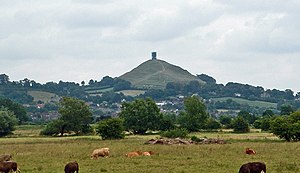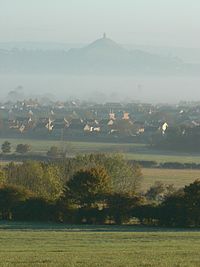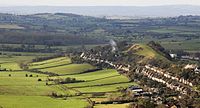Glastonbury Tor
| Glastonbury Tor | |
| Somerset | |
|---|---|
 Glastonbury Tor | |
| Summit: | 518 feet ST511386 51°8’40"N, 2°41’58"W |
Glastonbury Tor is a remarkable hill by Glastonbury in Somerset; a steep, solitary hill rising to 518 feet out of the flat, once flooded, lands of the Somerset Levels. It is topped by a roofless tower built as a chapel, St Michael's Tower.
The hill belongs today to the National Trust.
The Tor is a conical hill of clay and Blue Lias rising from the Somerset Levels. Its anomalous appearance is all in the geology: surrounding softer deposits were eroded over the ages, leaving the hard cap of sandstone exposed. The slopes of the hill are terraced, apparanetly for mediæval farming, but the method by which they were formed remains unexplained. Signs of the hand of man on the hill are found from many ages, from the Iron Age and Roman eras to modernity.
The Tor has assumed a place in Arthurian mythology and the modern mythology of neo-Paganism, which has become prevalent around Glastonbury.
Contents
Atop the hill
Several buildings were built on the summit during the Saxon and early mediæval periods; they have been interpreted as an early church and monks' hermitage. The original wooden church was destroyed by an earthquake in 1275, and the stone Church of St Michael built on the site in the 14th century. Its tower remains, although it has been restored and partially rebuilt several times.
St Michael's Tower is a Grade I listed building[1] and has been designated a scheduled monument.[2][3]
Archaeological excavations during the 20th century sought to clarify the background of the monument and church, but some aspects of their history remain unexplained.
Location and landscape
The Tor is in the middle of the Summerland Meadows, part of the Somerset Levels,[4] rising to an elevation of 518 feet.[2] The plain is reclaimed fen above which the Tor is clearly visible for miles around. It has been described as an island but actually sits at the western end of a peninsula washed on three sides by the River Brue.[5]
The Tor is formed from rocks dating from the early Jurassic Period, namely varied layers of Lias Group strata. The uppermost of these, forming the Tor itself, are a succession of rocks assigned to the Bridport Sand Formation. These rocks sit upon strata forming the broader hill on which the Tor stands; the various layers of the Beacon Limestone Formation and the Dyrham Formation.[6][7] The Bridport Sands have acted as a caprock protecting the lower layers from erosion. The iron-rich waters of Chalice Well, a spring at the base of the Tor, flow out as an artesian well impregnating the sandstone around it with iron oxides that have reinforced it to produce the caprock.[8] Iron-rich but oxygen-poor water in the aquifer carries dissolved iron (II) "ferrous" iron, but as the water surfaces and its oxygen content rises, the oxidised iron (III) "ferric" iron drops out as insoluble "rusty" oxides that bind to the surrounding stone, hardening it.[9]
The low-lying damp ground can produce a visual effect romantically known as a 'Fata Morgana' when the Tor appears to rise out of the mist.[10] This optical phenomenon occurs because rays of light are strongly bent when they pass through air layers of different temperatures in a steep thermal inversion where an atmospheric duct has formed.[11] The Italian term Fata Morgana is derived from the name of Morgan le Fay, a powerful sorceress in Arthurian legend.[12]
Terraces
The sides of the Tor have seven deep, roughly symmetrical terraces. Their formation remains a mystery[3] with many possible explanations. They may have been formed as a result of natural differentiation of the layers of Lias stone and clay used by farmers during the Middle Ages as terraced hills for agriculture.[13]
Other explanations have been suggested for the terraces, including the construction of defensive ramparts.[14] Iron Age hill forts including the nearby Cadbury Castle in Somerset show evidence of extensive fortification of their slopes. The normal form of ramparts is a bank and ditch, but there is no evidence of this arrangement on the Tor. South Cadbury, one of the most extensively fortified places in early Britain, had three concentric rings of banks and ditches supporting an 44-acre enclosure. By contrast, the Tor has seven rings and very little space on top for the safekeeping of a community.[15] The historian Ronald Hutton suggests that the terraces are the remains of a mediæval "spiral walkway" created for pilgrims to reach the church on the summit,[16] similar to that at Whitby Abbey.[17]
History
There is no evidence of permanent occupation of the Tor in an early age, but finds, including Roman pottery, do suggest that it was visited on a regular basis.[18]
Excavations between 1964 and 1966,[19] revealed evidence of Dark Age occupation during the 5th to 7th centuries[2][20] around the later mediæval church of St. Michael. Finds included postholes, two hearths including a metalworker's forge, two burials oriented north-south (thus unlikely to be Christian), fragments of 6th-century Mediterranean amphorae (vases for wine or cooking oil),[21] and a worn hollow bronze head which may have topped a Saxon staff.[22][23][24]
During the late Saxon and early mediæval period there were at least four buildings on the summit. The base of a stone cross demonstrates Christian use of the site during this period and it may have been a hermitage.[25] The broken head of a Sun cross|wheel cross dated to the 10th or 11th centuries was found part way down the hill and may have been the head of the cross that stood on the summit.[26][27][28] The head of the cross is now in the Museum of Somerset in Taunton.[29]
The earliest timber church, which was dedicated to St Michael,[30] is believed to have been constructed in the 11th or 12th century from which post holes have since been identified.[31][32] Associated monk cells have also been identified.[32]
St Michael's Church was destroyed by an earthquake on 11 September 1275.[33] According to the British Geological Survey, the earthquake was felt in London, Canterbury and Wales,[34] and was reported to have destroyed many houses and churches in England. The force was greater than 7 MSK, with its epicentre in the area around Portsmouth or Chichester.[33]
A second church, also dedicated to St Michael, was built of local sandstone in the 14th century by the Abbot Adam of Sodbury, incorporating the foundations of the previous building. It included stained glass and decorated floor tiles. There was also a portable altar of Purbeck Marble;[35] it is likely that the Monastery of St Michael on the Tor was a daughter house of Glastonbury Abbey. In 1243 Henry III granted a charter for a six-day fair at the site.[36]
St Michael's Church survived until the Dissolution of the Monasteries in 1539 when, except for the tower, it was demolished.[2] The last Abbot of Glastonbury, Richard Whiting, was hanged, drawn and quartered on the Tor for treason, along with two of his monks, John Thorne and Roger James.[37] The three-storey tower of St Michael's Church survives. It has corner buttresses and perpendicular bell openings. There is a sculptured tablet with an image of an eagle below the parapet.[1]
After the dissolution
In 1786, Richard Colt Hoare of Stourhead bought the Tor and funded repair of the tower in 1804, including the rebuilding of the north-east corner.[2][38] It was then passed on through several generations to the Reverend George Neville and included in the Butleigh Manor until the 20th century. In was then bought as a memorial to a former Dean of Wells, Thomas Jex-Blake, who died in 1915.[39]
The National Trust took control of the Tor in 1933, but repairs were delayed until after Second World War.[38] During the 1960s, excavations identified cracks in the rock, suggesting the ground had moved in the past. This, combined with wind erosion, started to expose the footings of the tower, which were repaired with concrete. Erosion caused by the feet of the increasing number of visitors was also a problem and paths were laid to enable them to reach the summit without damaging the terraces. After 2000, enhancements to the access and repairs to the tower, including rebuilding of the parapet, were carried out. These included the replacement of some of the masonry damaged by earlier repairs with new stone from the Hadspen Quarry.[38]
A model of Glastonbury Tor was incorporated into the opening ceremony of the 2012 Summer Olympics in London. As the athletes entered the stadium, their flags were displayed on the terraces of the model.[40][41][42]
Mythology and spirituality
The Tor has attracted a great deal of interest both from roamanticisers of Arthurian legend and form modern neo-pagans. It has been claimed as the "The Isle of Avalon" and the 12th and 13th-century writer Gerald of Wales asserted it to be so.[43] The Tor has therefore long been been associated with the name Avalon, and identified with King Arthur. This has ben particularly oso since the alleged discovery of King Arthur's and Queen Guinevere's neatly labelled coffins in 1191, recounted by Gerald of Wales.[44][45]
With the 19th-century resurgence of interest in Celtic mythology, the Tor became associated with Gwyn ap Nudd, the first Lord of the Otherworld (Annwn) and later King of the Fairies.[46][47] The Tor came to be represented as an entrance to Annwn or to Avalon, the land of the fairies.[48]
Outside links
| ("Wikimedia Commons" has material about Glastonbury Tor) |
- Glastonbury Tor information at the National Trust
References
- ↑ 1.0 1.1 National Heritage List 1345475: St Michael's Church Tower
- ↑ 2.0 2.1 2.2 2.3 2.4 National Heritage List 1019390: St Michael's Church, monastic remains, and other settlement remains on Glastonbury Tor
- ↑ 3.0 3.1 National Monuments Record: No. 196702 – Earthworks on Glastonbury Tor
- ↑ Siraut, Thacker & Williamson 2006a.
- ↑ Hawkins 1989, p. 69.
- ↑ "Geology of Britain viewer | British Geological Survey (BGS)". bgs.ac.uk. http://www.bgs.ac.uk/discoveringGeology/geologyOfBritain/viewer.html. Retrieved 6 June 2014.
- ↑ "Engineering Geology of British Rocks and Soils — Lias Group" (PDF). British Geological Survey. p. 2. http://nora.nerc.ac.uk/17270/1/OR12032.pdf. Retrieved 16 November 2013.
- ↑ Rahtz & Watts 2003, p. 20.
- ↑ Mann 2011, p. 17.
- ↑ Young 1807, p. 302.
- ↑ Young, Andrew. "An Introduction to Mirages". San Diego State University. http://mintaka.sdsu.edu/GF/mirages/mirintro.html. Retrieved 5 July 2010.
- ↑ "Morgan le Fay". Camelot Project. University of Rochester. http://d.lib.rochester.edu/camelot/theme/morgan. Retrieved 28 October 2013.
- ↑ Rahtz & Watts 2003, p. 67.
- ↑ Vallins 2013.
- ↑ Mann 1986, p. 32.
- ↑ MacLaran & Scott 2009.
- ↑ Hutton 2006, p. 79.
- ↑ Rahtz & Watts 2003, p. 71.
- ↑ "Excavation (1964–1966), Glastonbury Tor". Somerset Historic Environment Record. Somerset County Council. http://webapp1.somerset.gov.uk/her/details.asp?prn=44979. Retrieved 27 October 2013.
- ↑ Rahtz & Watts 2003, pp. 71–78.
- ↑ "Extracts from the Tor Excavations Booklet". Chalice Well. http://www.chalicewell.org.uk/index.cfm/glastonbury/HistoricalArchive.Article/article_id/27. Retrieved 26 October 2013.
- ↑ Castleden 1999, p. 55.
- ↑ "Prehistoric, Roman and Post-Roman occupation, Glastonbury Tor". Somerset Historic Environment Record. Somerset County Council. http://webapp1.somerset.gov.uk/her/details.asp?prn=23603. Retrieved 27 October 2013.
- ↑ Walmsley 2013, p. 15.
- ↑ "Late Saxon and mediæval occupation, Glastonbury Tor". Somerset Historic Environment Record. Somerset County Council. http://webapp1.somerset.gov.uk/her/details.asp?prn=23604. Retrieved 27 October 2013.
- ↑ Rahtz & Watts 2003, p. 78.
- ↑ Abrams & Carley 1991, p. 33.
- ↑ Koch 2006, p. 816.
- ↑ "Frome Hoard finds new home at the centre of new Somerset Museum". Culture 24. http://www.culture24.org.uk/history-and-heritage/archaeology/art365271. Retrieved 27 October 2013.
- ↑ Rahtz & Watts 2003, p. 80.
- ↑ "Church of St Michael, The Tor, Glastonbury". Somerset Historic Environment Record. Somerset County Council. http://webapp1.somerset.gov.uk/her/details.asp?prn=23605. Retrieved 27 October 2013.
- ↑ 32.0 32.1 Rahtz & Watts 2003, p. 79.
- ↑ 33.0 33.1 "Historical Earthquake Listing". British Geological Survey. Archived from the original on 19 November 2007. http://web.archive.org/web/20071119072210/http://www.quakes.bgs.ac.uk/earthquakes/historical/historical_listing.htm. Retrieved 25 December 2007.
- ↑ Musson 2003, pp. 1.14–1.16.
- ↑ Rahtz & Watts 2003, pp. 80–81.
- ↑ Rahtz & Watts 2003, p. 83.
- ↑ Stanton 1892, p. 538.
- ↑ 38.0 38.1 38.2 Garner 2004.
- ↑ Siraut, Thacker & Williamson 2006b.
- ↑ Dewsbury, Rick; Garland, Ian (27 July 2012). "Britain fires up the world: London gets the 2012 Games under way with the Greatest Show On Earth (rounded off by Macca, of course)". Mail Online. http://www.dailymail.co.uk/news/article-2179920/Olympics-Opening-Ceremony-London-gets-2012-Games-way-Greatest-Show-On-Earth-rounded-Macca-course.html?ITO=1490. Retrieved 28 July 2012.
- ↑ "Glastonbury Tor's starring role in London 2012 Olympic Games opening ceremony". This is Somerset. http://www.thisissomerset.co.uk/Glastonbury-Tor-s-starring-role-London-2012/story-16609128-detail/story.html. Retrieved 27 October 2013.
- ↑ Waite, Richard. "Glastonbury Tor, a village green and a farmyard — Olympic opening ceremony plans revealed". Architects' Journal. http://www.architectsjournal.co.uk/news/daily-news/glastonbury-tor-a-village-green-and-a-farmyard-olympic-opening-ceremony-plans-revealed/8631595.article. Retrieved 27 October 2013.
- ↑ "Gerald of Wales". Sources of British History. Britannia. http://www.britannia.com/history/docs/debarri.html. Retrieved 2 December 2013.
- ↑ Nitze 1934, pp. 355–361.
- ↑ Ditmas 1964, pp. 19–33.
- ↑ Bowman 2005, p. 178.
- ↑ Bowman 2008, p. 251.
- ↑ Emick, Jennifer (2008). The Everything Celtic Wisdom Book. Adams Media. pp. 96–97. ISBN 978-1-4405-2170-6. http://books.google.co.uk/books?id=5skKKMRUHAMC&pg=PT109&lpg=PT109&dq=Annwn+Glastonbury+Tor&source=bl&ots=mYMh_MtzAi&sig=kFn3QYnhbcCXKNJhMVNPlu1fK8o&hl=en&sa=X&ei=DU-zUtm9J-eX4wTYoIHwBg&ved=0CFkQ6AEwBA#v=onepage&q=Annwn%20Glastonbury%20Tor&f=false.
Books
- Abrams, Lesley; Carley, James (1991). The Archaeology and History of Glastonbury Abbey: Essays in Honour of the Ninetieth Birthday of C. A. Ralegh Radford. Boydell Press. ISBN 978-0-85115-284-4.
- Adkins, Lesley; Adkins, Roy (1992). A Field Guide to Somerset Archaeology. Dovecote Press. ISBN 978-0-946159-94-9.
- Allcroft, Arthur Hadrian (1908). Earthwork of England: Prehistoric, Roman, Saxon, Danish, Norman and Mediæval. Nabu Press. ISBN 978-1-178-13643-2.
- Bowden-Pickstock, Susan (2009). Quiet Gardens: The Roots of Faith?. Continuum International Publishing Group. ISBN 978-1-84706-341-0. http://books.google.com/?id=tznuhNOQ6EcC&pg=PA107&lpg=PA107&dq=Geoffrey+Russell+Glastonbury+Tor#v=onepage&q=Geoffrey%20Russell%20Glastonbury%20Tor&f=false.
- Bowman, Marion (2004). "Procession and Possession in Glastonbury: Continuity, Change and the Manipulation of Tradition". Folklore 115 (3): 273–85. doi:10.1080/0015587042000284266. http://www.jstor.org/stable/30035212.
- Bowman, Marion (2005). "Ancient Avalon, New Jerusalem, Heart Chakra of Planet Earth: The Local and the Global in Glastonbury" (PDF). Numen International Review for the History of Religions 52 (2): 157–190. doi:10.1163/1568527054024722. http://oro.open.ac.uk/2909/.
- Bowman, Marion (2008). "Going with the flow: Contemporary pilgrimage in Glastonbury". in Margry, Peter Jan. Shrines and Pilgrimage in the Modern World: New Itineraries into the Sacred. Amsterdam University Press. pp. 241–280. ISBN 978-90-8964-011-6.
- Castleden, Rodney (1999). King Arthur: The Truth Behind the Legend. Routledge. ISBN 978-0-415-19575-1.
- Ditmas, E.M.R. (1964). "The Cult of Arthurian Relics". Folklore 75 (1): 19. doi:10.1080/0015587X.1964.9716942.
- Ekwall, Eilert (1960). The Concise Oxford Dictionary of English Place Names. Oxford University Press. ISBN 978-0-19-869103-7.
- Garner, Keith (2004). "Survival of an ancient tower". Building Conservation Journal (35): 18–21. http://www.kgarch.co.uk/writing/glastonbury/index.htm.
- Gathercole, Clare (2003). "Glastonbury" (PDF). Somerset Urban Archaeological Survey. Somerset County Council. http://www1.somerset.gov.uk/archives/hes/downloads/Somerset_EUS_Glastonbury.pdf. Retrieved 27 October 2013.
- Gray, Louis H. (January 1935). "The origin of the name of Glastonbury". Speculum 10 (1). doi:10.2307/2848235.
- Hawkins, Desmond (1989). Avalon and Sedgemoor. Tabb House. ISBN 978-0-907018-72-8.
- Hodapp, Christopher; Von Kannon, Alice (2007). The Templar Code for Dummies. John Wiley & Sons. ISBN 978-0-470-12765-0.
- Hutton, Ronald (2006). Witches, Druids and King Arthur. Hambledon Continuum. ISBN 978-1-85285-555-0. http://books.google.com/?id=QqPbJQkSo8EC&printsec=frontcover#v=snippet&q=Glastonbury%20Tor&f=false.
- Hutton, Ronald (2013). Pagan Britain. Yale University Press. ISBN 978-0-300-19771-6. http://books.google.com/?id=3Zf9AQAAQBAJ&printsec=frontcover#v=onepage&q&f=false.
- Ivakhiv, Adrian (2001). Claiming Sacred Ground: Pilgrims and Politics at Glastonbury and Sedona. Indiana University Press. ISBN 978-0-253-33899-0. http://books.google.com/?id=QNHTOvnZ3poC&pg=PA112&lpg=PA112&dq=Glastonbury+Zodiac+water+covered#v=onepage&q=Glastonbury%20Zodiac%20water%20covered&f=false.
- Koch, John T. (2006). Celtic Culture: A Historical Encyclopedia. ABC-CLIO Ltd. ISBN 978-1-85109-440-0. http://books.google.com/?id=f899xH_quaMC&pg=PA816&lpg=PA816&dq=Glastonbury+Tor+wheel+cross+Abrams#v=onepage&q=Glastonbury%20Tor%20wheel%20cross%20Abrams&f=false.
- MacLaran, Pauline; Scott, Linda M. (2009). "Magic and Merchandise Spiritual Shopping in Glastonbury". Advertising and Society Review 10 (4). doi:10.1353/asr.0.0039. http://muse.jhu.edu/journals/advertising_and_society_review/v010/10.4.maclaran.html.
- MacQueen, Gailand (2005). Spirituality of Mazes and Labyrinths. Northstone Publishing. ISBN 978-1-896836-69-0. http://books.google.com/?id=-kXbPNbhKYAC&pg=PA106&lpg=PA106&dq=Geoffrey+Russell+Glastonbury+Tor#v=onepage&q=Geoffrey%20Russell%20Glastonbury%20Tor&f=false.
- Maltwood, Katherine (1987). Guide to Glastonbury's Temple of the Stars. James Clarke & Co. ISBN 978-0-227-67867-1.
- Mann, Nicholas R. (2011). Glastonbury Tor: A Guide to the History and Legends. The Temple Publications. ISBN 978-0-9557400-8-4.
- Mann, Nicholas R. (1986). Glastonbury Tor: A Guide to the History and Legends. Annenterprise. ISBN 978-1-85613-151-3.
- Musson, R.W.W (2003). "Fatalities in British earthquakes". Astronomy and Geophysics 44 (1): 1.14–1.16. doi:10.1046/j.1468-4004.2003.44114.x.
- Nitze, W.A. (1934). "The exhumation of King Arthur at Glastonbury". Speculum 19 (4).
- Rahtz, Philip (1993). English Heritage Book of Glastonbury. Batsford. ISBN 978-0-7134-6866-3.
- Rahtz, Phillip; Watts, Lorna (2003). Glastonbury: Myth and Archaelogy. Tempus Publishing. ISBN 978-0-7524-2548-1.
- Robinson, Stephen (1992). Somerset Place Names. Dovecote Press. ISBN 978-1-874336-03-7.
- Siraut, M.C.; Thacker, A.T.; Williamson, Elizabeth (2006a). "Introduction". in Dunning, R.W.. A History of the County of Somerset: Volume 9: Glastonbury and Street. Institute of Historical Research. http://www.british-history.ac.uk/report.aspx?compid=117171. Retrieved 26 October 2013.
- Siraut, M.C.; Thacker, A.T.; Williamson, Elizabeth (2006b). "Glastonbury: Parish". in Dunning, R.W.. A History of the County of Somerset: Volume 9: Glastonbury and Street. Institute of Historical Research. http://www.british-history.ac.uk/report.aspx?compid=117176. Retrieved 26 October 2013.
- Stanton, Richard (1892). A Menology of England and Wales. Burns & Oates. http://archive.org/stream/menologyofenglan00stanrich#page/538/mode/2up.
- Vallins, John (24 June 2013). "History and myth entangled around Somerset's most notable landmark". Guardian. http://www.theguardian.com/environment/2013/jun/24/glastonbury-tor-history-myth-somerset. Retrieved 27 October 2013.
- Walmsley, Eric (2013). King Arthur's Battle for Britain. Matador. ISBN 978-1-78088-400-4. http://books.google.com/?id=0CL_Z3Uchk8C&pg=PA15&lpg=PA15&dq=Glastonbury+Tor+bronze+head#v=onepage&q=Glastonbury%20Tor%20bronze%20head&f=false.
- Wylie, John (2002). "An essay on ascending Glastonbury Tor". Geoforum 33 (4): 441–454. doi:10.1016/S0016-7185(02)00033-7. http://www.sciencedirect.com/science/article/pii/S0016718502000337.
- Young, Thomas (1807). A Course of Lectures on Natural Philosophy and the Mechanical Arts. Johnson. http://books.google.com/?id=lmM_AAAAcAAJ&pg=PA302&lpg=PA302&dq=Mirage+Glastonbury+Tor#v=onepage&q=Glastonbury%20Tor&f=false.
Further reading
- Page, William, ed (1906). "Geology". A History of the County of Somerset: Volume 1. Institute of Historical Research. http://www.british-history.ac.uk/report.aspx?compid=117301. Retrieved 26 October 2013.
- Rahtz, Philip (1971). "Glastonbury Tor". in Ashe, Geoffrey. The Quest for Arthur's Britain. HarperCollins. ISBN 978-0-586-08044-3.
- Snyder, Christopher A. (1998). An Age of Tyrants: Britain and the Britons, A.D. 400–600. Penn State Press. ISBN 978-0-271-04362-3. http://books.google.com/?id=AFxFkwmnRJMC&pg=PA178&lpg=PA178&dq=Glastonbury+Tor+bronze+head#v=onepage&q=Glastonbury%20Tor%20bronze%20head&f=false.
- Truscoe, Krystyna (2004). "Report for Aerial Survey Component Block 2: Somerset Levels" (PDF). The Aggregate Landscape of Somerset: Predicting the Archaeological Resource. English Heritage. http://www.english-heritage.org.uk/publications/aggregate-landscape-of-somerset-levels/Somerset_ALSF_NMP_Block2_Somerset_Levels_web.pdf. Retrieved 26 October 2013.





